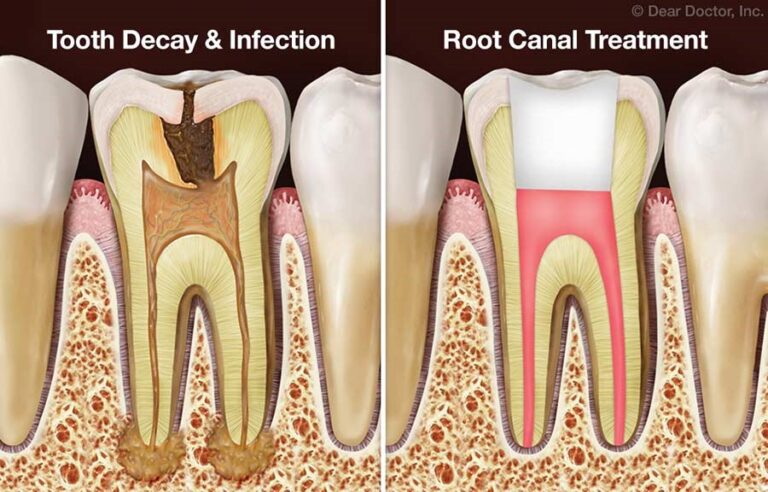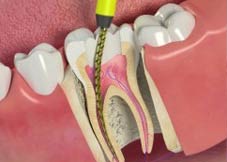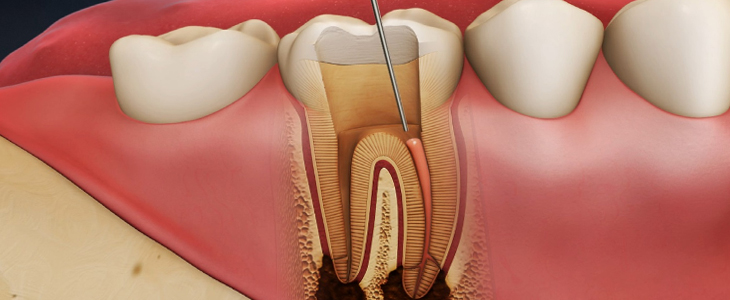ENDODONTICS
RCT, Fillings, Inlays/Onlays & Internal Bleaching
ENDODONTICS
This branch of dentistry embraces the practice of saving the natural teeth with various kinds of direct and indirect restorations. The primary goal is prevention, diagnosis and treatment of sequelae of dental caries and the other defects of natural teeth, carrying out techniques and procedures to restore the teeth to full function and appearance in an aesthetically pleasing manner with as little loss of the healthy tooth structure as possible.
The treatment provided includes various fillings with regular dental cements/inlays/onlays, root canal treatment, post and core, surgical endodontics, endodontic implants, bleaching, & management of traumatized teeth. Root canal treatment and associated surgical procedures are performed to rid the tooth of its offending malady. The early manifestation of the cavity process is a small patch of demineralised (softened) enamel at the tooth surface, often hidden from sight in the fissures (grooves) of teeth or in between the teeth. The destruction spreads into the softer, sensitive part of the tooth beneath the enamel (dentine). The weakened enamel then collapses to form a cavity and the tooth is progressively destroyed. Caries can also attack the roots of teeth should they become exposed by recession of the gums. This is more common in older adults.
Endodontic treatment, or root canal treatment, treats the soft pulp tissue of the decayed /cracked/ traumatized/severely attrited teeth, thereby preserving the natural teeth. Rotary endodontics simplified the procedure and reduced the number of sittings t just one.
Apicoectomy is a surgical procedure through which the tip of a root is removed, and a root-end filling is placed, preventing bacterial leakage into the root canal system from the tissues surrounding the root. This procedure can be carried out when a previous root canal treatment fails, and re-root canal treatment is not possible.
Apexification is a procedure done to induce a calcific barrier in a root with incomplete formation or open root tip of a tooth with damaged pulp. Pulpal involvement usually occurs as a consequence of trauma or cavity involvement of young or immature permanent teeth. The objective of this procedure is to induce root end closure at the tips of immature roots through the formation of mineralized tissue.
Tooth hemisection is a type of endodontic surgery in which a root and its overlying portion of the crown are separated from the rest of the tooth, and optionally removed.
Internal bleaching is a process which is done after a tooth has been root canal treated. This means that the tooth will have had the nerve of the tooth removed through a root canal treatment because of which discolouration becomes a problem due to the lack of nerve supply to that tooth. It is common to have this internal bleaching done on upper front teeth as they are visible during smiling and talking.
Regenerative Endodontic Procedures (REPS) is defined as biologically based procedures designed to replace damaged structures such as dentin, root structures, and cells of the pulp-dentin complex.This new treatment modality aims to promote normal function of the pulp. It has become an alternative to heal apical periodontitis. Regenerative endodontics is the extension of root canal therapy. Conventional root canal therapy cleans and fills the pulp chamber with biologically inert material after destruction of the pulp due to dental caries, congenital deformity or trauma.
Regenerative endodontics instead seeks to replace live tissue in the pulp chamber. The ultimate goal of REPS is to regenerate the tissues and the normal function of the dentin-pulp complex.




